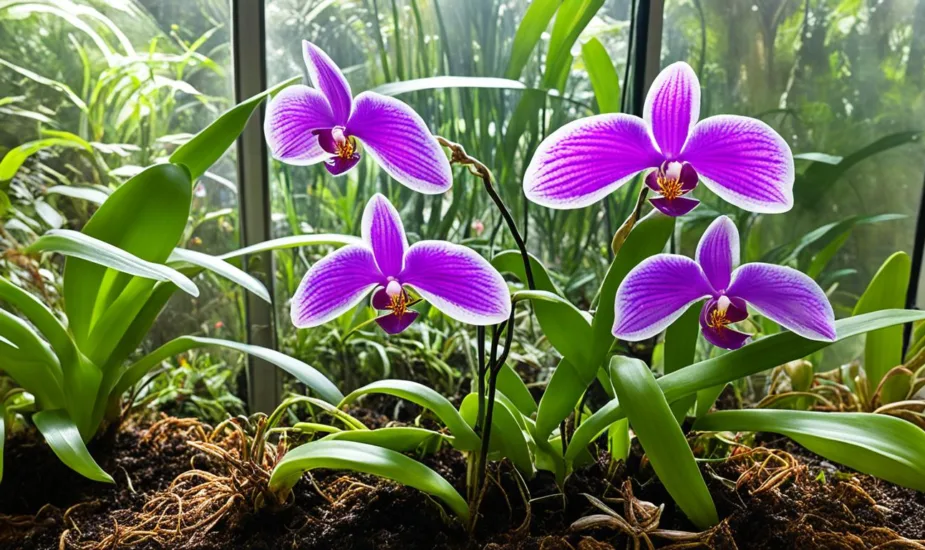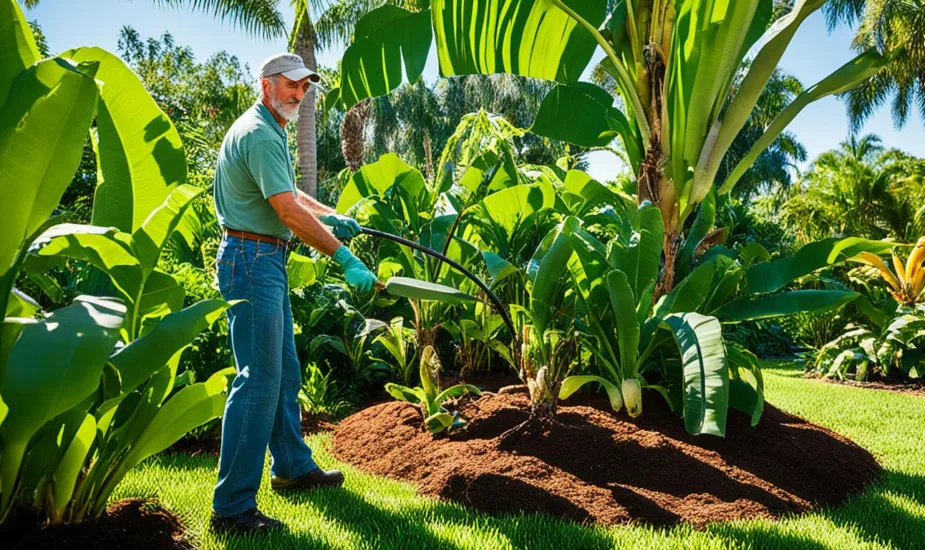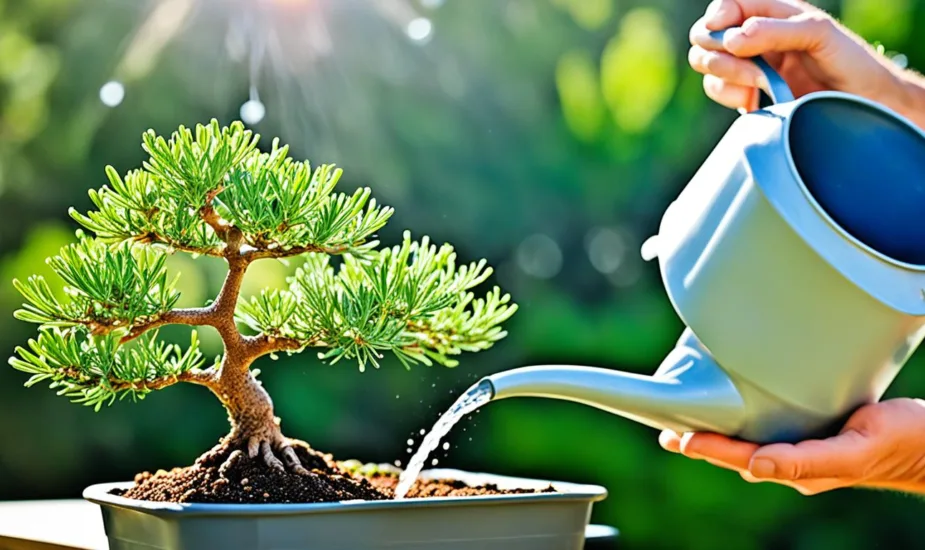Rosemary Plant Care in Florida: Essential Tips
Discover essential tips for rosemary plant care in Florida to ensure your herb thrives year-round. Learn best practices for healthy growth!
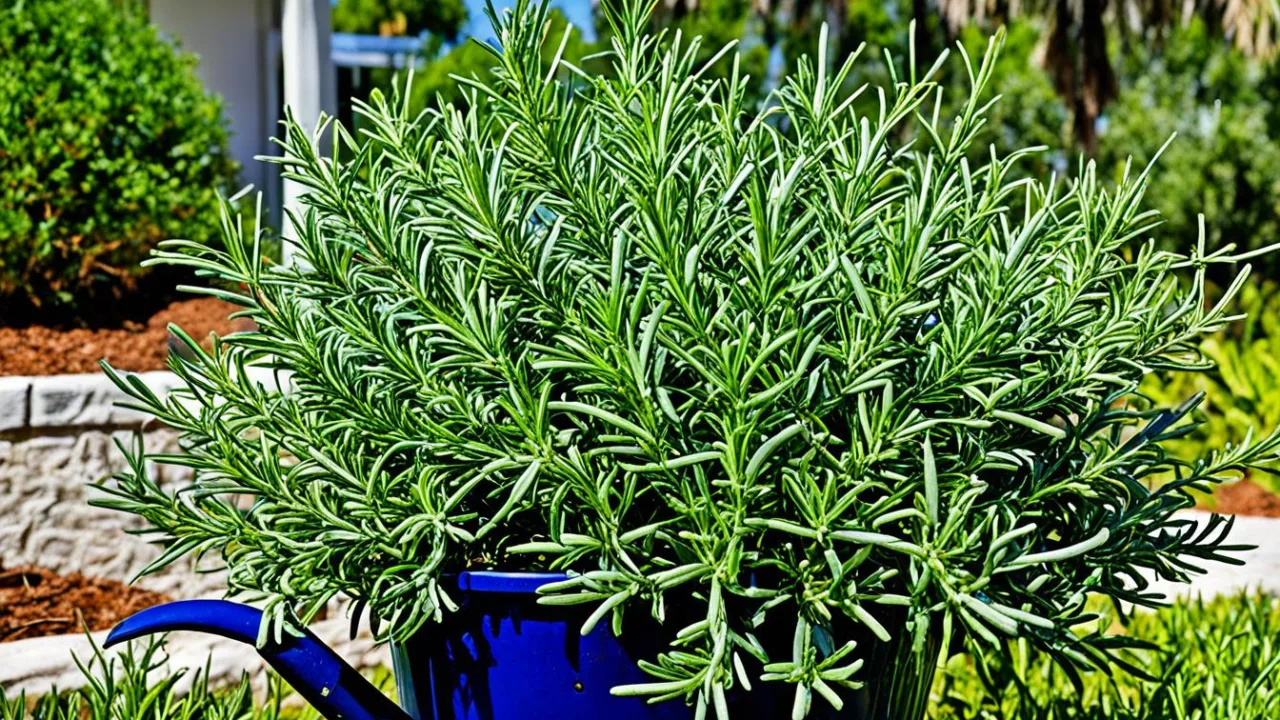
As a resident of sunny Florida, I love bringing the beauty of nature into my home. One plant that has captivated me with its aromatic fragrance and versatility is rosemary. This hardy herb not only enhances the flavors of my favorite dishes but also adds charm to my landscape.
Let me tell you a little story. Last year, I decided to create my very own herb garden, starting with a small rosemary plant. I carefully nurtured it, ensuring it received the right amount of sunlight, well-drained soil, and occasional water. To my delight, the plant thrived, growing into a lush bush that brought a touch of sophistication to my garden.
Not only is rosemary a culinary delight, but it also adds an elegant touch to any outdoor space. Its small flowers, which bloom in various colors during winter and spring, are a delightful sight to behold. Plus, rosemary is a hardy plant, resistant to pests and diseases, making it an ideal choice for any Florida garden.
If you’re considering growing rosemary in Florida, you’ve come to the right place. In this article, I’ll share essential tips on rosemary plant care that will help you successfully cultivate this wonderful herb in the Sunshine State.
Key Takeaways:
- Rosemary is a fragrant herb that adds flavor to cooking and beauty to landscaping.
- It requires well-drained soil, at least six hours of sunlight, and moderate watering.
- Rosemary is drought-tolerant, pest-resistant, and blooms in winter and spring.
- Florida rosemary is not edible and should not be confused with culinary rosemary.
- By following these essential tips, you can successfully grow rosemary in your Florida garden.
Planting and Growing Rosemary in Florida
When it comes to growing rosemary in Florida, there are a few key factors to keep in mind. Whether you choose to plant it in containers or landscape beds, rosemary is a versatile herb that can thrive year-round in the state with the right care. Here are some essential tips on how to successfully grow and care for rosemary in Florida:
Choosing the Right Location and Planting
Rosemary requires well-drained soil and at least six hours of sunlight each day. It is best to choose a location that offers full sun exposure to ensure optimal growth and development. Florida’s climate provides the perfect conditions for rosemary, but in colder areas, it may need protection from freezes. When planting, make sure to space the plants adequately to allow for air circulation and prevent overcrowding.
Acquiring Rosemary Plants
One of the best ways to start growing rosemary in Florida is by purchasing plants from a local garden center. This ensures that you get a healthy and well-established plant that has already adapted to the region’s climate. Alternatively, you can start rosemary from cuttings, which is relatively easy and allows you to propagate multiple plants from a single mother plant.
Soil and Watering Requirements
Growing rosemary in well-drained soil is crucial to prevent root rot and ensure the plant’s healthy growth. You can amend the soil with sandy or loamy material to improve drainage if necessary. Overwatering can be detrimental to rosemary plants, so it’s essential to let the soil dry out between waterings. Remember, rosemary is drought-tolerant and prefers slightly dry conditions over excessive moisture. Regular watering is typically required only during the dry spells.
Fertilizer and Pruning
Rosemary generally doesn’t require a lot of fertilizer. Too much nitrogen can lead to excessive foliage growth at the expense of flowering and fragrance. It’s advisable to use a balanced fertilizer sparingly and follow the recommended dosage. As for pruning, rosemary responds well to regular trimming. This helps maintain its shape, promote bushier growth, and prevent it from becoming leggy. Pruning should not exceed more than one-third of the plant’s growth at a time to avoid stress and maintain its overall health.
Pest and Disease Control
One of the advantages of growing rosemary in Florida is its resilience against major pests and diseases. However, overwatering is the primary cause of plant decline, making it crucial to maintain proper drainage. To prevent any potential issues, inspect your rosemary plants regularly for signs of pest infestation or disease symptoms. Early detection allows for prompt intervention with appropriate treatments, if necessary.
Table: Recommended Growing Conditions for Rosemary in Florida
| Aspect | Recommendation |
|---|---|
| Sunlight | At least 6 hours of direct sun per day |
| Soil | Well-drained, sandy or loamy soil |
| Watering | Sparingly, allowing the top few inches of soil to dry out |
| Fertilizer | Use balanced fertilizer sparingly |
| Pruning | Regular trimming to maintain shape and promote bushier growth |
Best Practices for Rosemary Care in Florida
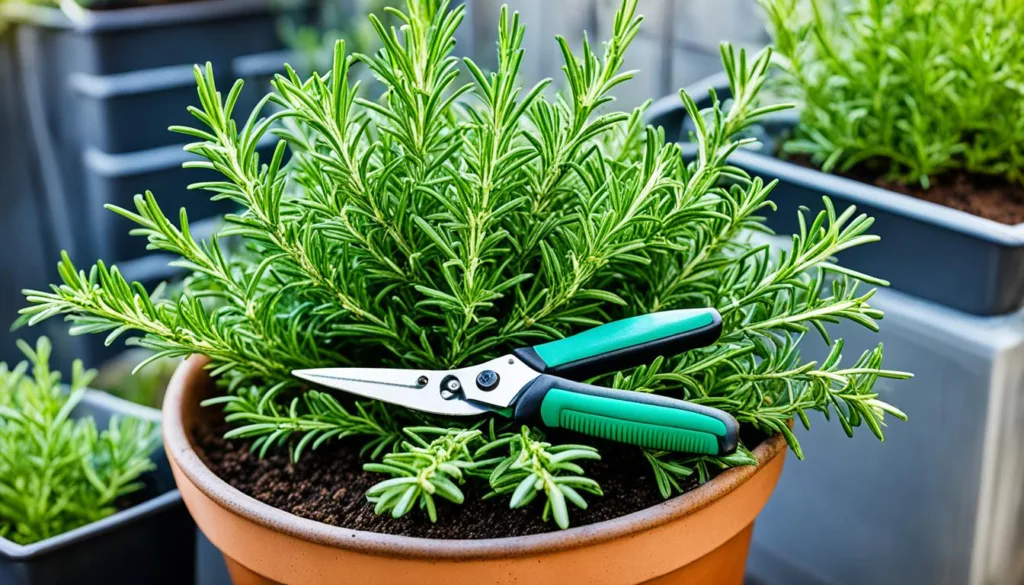
Ensuring the health and growth of rosemary in Florida requires following some essential care practices. By adhering to these guidelines, you can cultivate robust and vibrant rosemary plants that thrive in the unique climate of the state. Here are the best practices for caring for rosemary in Florida:
-
Planting Time: It’s crucial to plant rosemary in spring, once all risk of frost has passed, or in containers that can be easily moved indoors during winter. This timing allows the plant to establish roots before the hot summer months while avoiding any potential cold damage.
-
Well-Drained Soil: Rosemary prefers sharp drainage and cannot tolerate excessive moisture. To provide optimal growing conditions, select a well-draining soil mix. Enriching the soil with compost helps improve the drainage while providing essential nutrients to the plant.
-
Regular Feeding: To encourage healthy growth and maximize the flavor of the herb, feed rosemary regularly with a balanced liquid fertilizer. Follow the manufacturer’s instructions for application rates and frequency, ensuring you don’t overfertilize, which can harm the plant.
-
Watering: Rosemary is drought-tolerant and thrives in dry conditions. Allow the top few inches of soil to dry out between waterings. Overwatering can lead to root rot and other problems. By practicing moderate watering, you can promote robust growth while preventing water-related issues.
-
Sunlight and Air Circulation: Rosemary loves warm weather and moderate humidity levels. Provide your plants with at least six hours of direct sunlight per day. Good air circulation is also essential to prevent fungal diseases, so avoid overcrowding the plants and make sure they have adequate space.
-
Pruning: Prune rosemary to shape the plant and promote bushier growth. However, avoid removing more than one-third of the plant’s growth at a time to prevent excessive stress. Regular pruning helps maintain an attractive appearance and improves air circulation within the plant.
By following these best practices, you can ensure that your rosemary plants in Florida thrive and provide you with abundant herbs for culinary and aromatic uses.
Essential Care Practices for Rosemary in Florida
| Best Practices | Description |
|---|---|
| Planting Time | Plant rosemary in spring after the threat of frost or in containers that can be moved indoors during winter. |
| Well-Drained Soil | Use soil with sharp drainage and enrich it with compost for optimal growth. |
| Regular Feeding | Feed rosemary with a balanced liquid fertilizer to promote healthy growth and maximize flavor. |
| Watering | Water sparingly, allowing the top few inches of soil to dry out between waterings. |
| Sunlight and Air Circulation | Provide at least six hours of direct sunlight per day and ensure good air circulation around the plants. |
| Pruning | Prune rosemary to shape the plant and improve air circulation, avoiding excessive stress. |
Harvesting and Using Rosemary
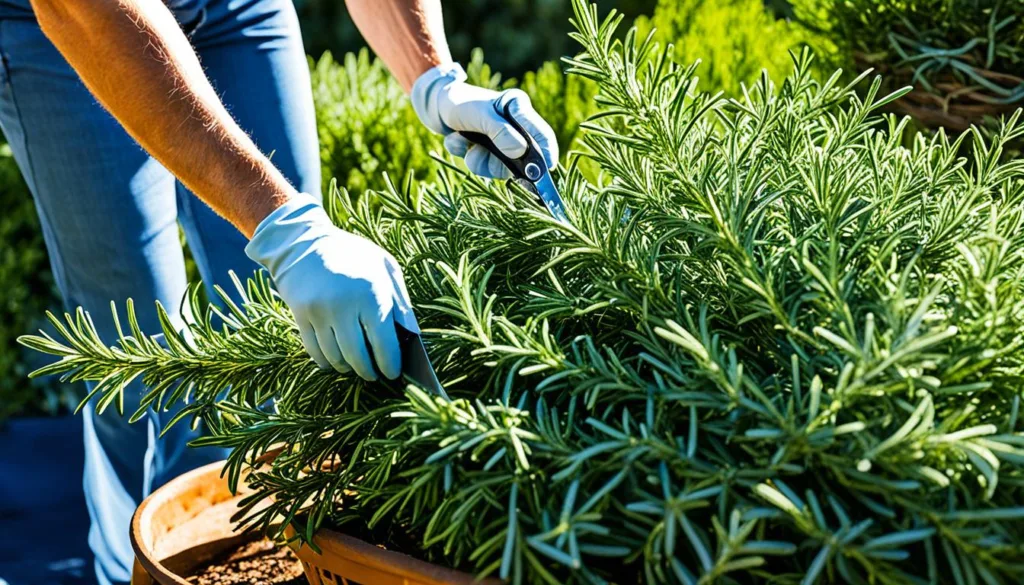
Rosemary is a versatile herb that can be harvested and used in a variety of ways. Whether you want to enhance the flavor of your dishes or preserve the herb for later use, there are several methods to consider.
Harvesting Fresh Rosemary
To harvest rosemary, wait until the plant is mature and just before it blooms. This is when the herb is most flavorful and aromatic. Using sharp gardening shears, cut off 4- to 6-inch stem tips from the plant. Harvesting in moderation will ensure the plant continues to thrive.
Using Rosemary in Cooking
Fresh rosemary can be a delightful addition to your culinary creations. The herb pairs well with a variety of dishes, including roasted meats, vegetables, and soups. Simply chop the fresh leaves and add them to your favorite recipes to enjoy the herb’s distinct flavor and aroma.
Drying Rosemary
If you have an abundance of rosemary, drying the herb allows you to enjoy its flavors throughout the year. To dry rosemary, gather several stems and tie them together with a string. Hang the stems upside down in a cool, well-ventilated area for a couple of weeks. Once the herb is dry, strip the leaves off the stems and store them in an airtight container.
Preserving Rosemary
In addition to drying, there are other methods for preserving rosemary. One option is to freeze the herb, either whole or chopped, in an airtight container. This allows you to have fresh rosemary on hand whenever you need it. Another method is to preserve rosemary in vinegar, creating a flavorful infusion that can be used in dressings, marinades, and other recipes. You can also use rosemary to make bouquet garni, a bundle of herbs tied together and used to infuse flavors in soups and stews.
By harvesting rosemary at its peak and using it in various ways, you can fully enjoy the flavors and benefits of this versatile herb.
Growing Rosemary in Containers
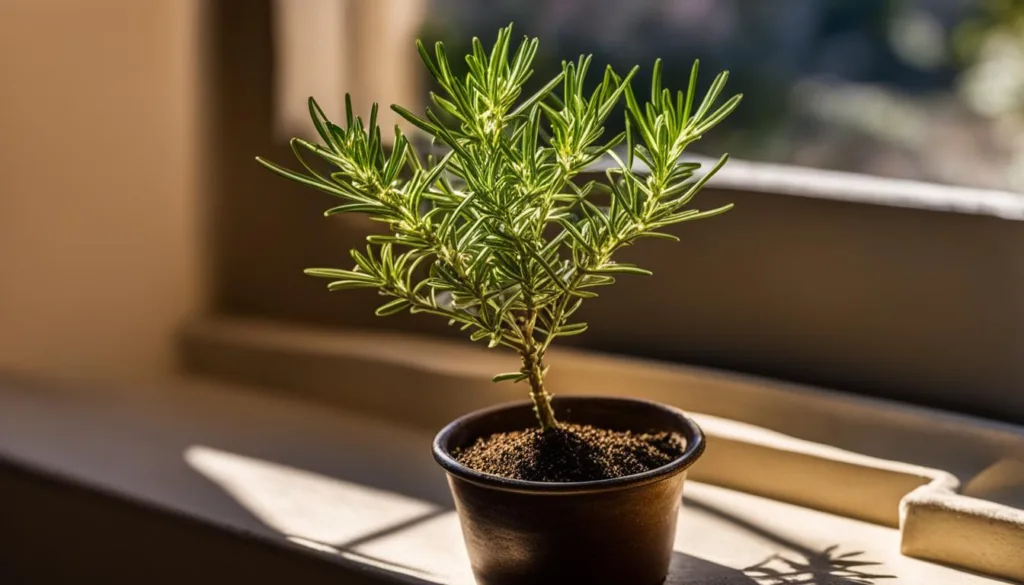
If you don’t have space for a garden or prefer to keep your rosemary close at hand, growing rosemary in containers is an excellent option. Not only does it allow you to control the growing conditions, but it also makes it easier to care for your potted rosemary plants.
When selecting a container for your rosemary, choose one that is slightly larger than the root ball and has drainage holes to prevent waterlogged soil. An unglazed clay pot is particularly suitable as it allows for proper moisture evaporation and prevents root rot.
The soil you use for your potted rosemary is crucial for its overall health and growth. Opt for a well-draining and lightweight soil mix that contains perlite to promote proper drainage and prevent water accumulation. This will help prevent root rot and other moisture-related issues.
Indoor rosemary plants should be placed in a sunny spot where they can receive at least six hours of direct sunlight daily. If you don’t have access to sufficient natural light, consider using grow lights to supplement the required light levels.
TIP: Rosemary is a Mediterranean herb that craves sunlight, so make sure to provide it with ample light to ensure its proper growth and development.
Watering your potted rosemary should be done sparingly to prevent overwatering. Allow the soil to dry out between waterings, as rosemary is drought tolerant and prefers slightly dry conditions. This will help prevent root rot and keep your plant healthy.
Pruning is an essential aspect of caring for potted rosemary. While pruning can help shape the plant and promote bushier growth, excessive pruning should be avoided. Removing more than one-third of the plant’s growth at a time can stress the plant and make it more vulnerable to diseases and pests.
Tips and Guidelines: Growing Rosemary in Containers
- Choose a slightly larger container with drainage holes to allow for proper moisture evaporation and prevent root rot.
- Use a well-draining and lightweight soil mix with perlite to promote drainage and prevent water accumulation.
- Place your potted rosemary in a sunny spot, ensuring it receives at least six hours of direct sunlight daily. Consider using grow lights if natural light is insufficient.
- Water sparingly and allow the soil to dry out between waterings to prevent overwatering and root rot.
- Prune as necessary to shape the plant, but avoid excessive pruning to prevent stress and vulnerability to diseases and pests.
By following these guidelines for growing rosemary in containers, you can enjoy the benefits of this versatile herb even in limited spaces. Whether you prefer to keep it indoors or outdoors, potted rosemary will add a touch of fragrance and flavor to your home and culinary creations.
Conclusion
Growing and caring for rosemary in Florida is relatively easy if you follow the essential tips and best practices mentioned in this article. By providing the right conditions such as well-drained soil, sufficient sunlight, and proper water and fertilizer management, you can ensure that your rosemary plants thrive year-round in the Sunshine State.
Whether you choose to plant rosemary in containers or in landscape beds, this fragrant herb can bring both beauty and flavor to your garden. Its versatility makes it a great addition to your cooking, enhancing the taste and aroma of various dishes. Just remember to use the correct rosemary variety and not confuse it with the non-edible Florida rosemary.
By understanding the specific care needs of rosemary, such as planting in spring, regular pruning, and providing adequate warmth and humidity, you can enjoy the benefits of this wonderful herb in your Florida landscape. So, go ahead and start your rosemary garden, and unlock the full potential of this versatile and aromatic plant.
 Little Garden Tips
Little Garden Tips




